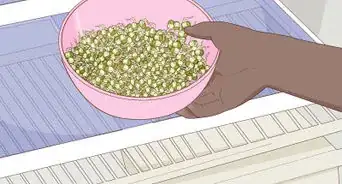This article was co-authored by wikiHow Staff. Our trained team of editors and researchers validate articles for accuracy and comprehensiveness. wikiHow's Content Management Team carefully monitors the work from our editorial staff to ensure that each article is backed by trusted research and meets our high quality standards.
The wikiHow Video Team also followed the article's instructions and verified that they work.
This article has been viewed 25,147 times.
Learn more...
Rice is a versatile grain that you can use in all sorts of recipes, so it’s always good to have some on hand. Store uncooked rice in an air-tight container in a cool, dry place. If your rice is already cooked, store it in the refrigerator or freezer to prevent it from spoiling. Follow some simple guidelines to ensure that your rice is ready when you need it for a recipe, or just enjoy it on its own!
Steps
Storing Uncooked Rice
-
1Select an airtight container made from plastic, glass, or metal. Good choices include food-safe plastic containers, enamel lined #10 cans, mylar-type bags, and glass jars. Make sure that any container you use has a tightly-fitting lid.[1]
- You could also look for a container that has a pour spout to easily dispense the rice.
- Containers with measurements marked on the sides may also be helpful for seeing how much rice you have.
-
2Place the rice in the container and seal it tightly. Remove the rice from its bag and transfer it to the airtight container you have selected. Seal the container immediately after the rice is in it.[2]
- If you’re using a bag, press the air out of it before you seal it. This will help to promote a longer shelf life.
- This method can be especially useful if you need to store large amounts of rice.
Advertisement -
3Store the rice in a cupboard or other cool, dry space. This will help to protect the rice from light and moisture, which can cause it to degrade faster. Opt for a cupboard that’s up off the ground to help protect your rice from any pests that might try to get into it.[3]
- You can also place the rice container in your refrigerator or freezer, which may be a good option if you live in a very hot, humid climate or if you are concerned about pests invading your rice.
- Since there’s no water in dry, uncooked rice, it won’t freeze. It may feel cool to the touch when you first remove it from the fridge or freezer, but you can use it right away.
- Make sure that you discard the rice if it becomes contaminated by bugs or other pests.
-
4Use white rice within 1-2 years and brown rice within 6-12 months. Although properly stored uncooked white rice will often last indefinitely, using it within 1-2 years will help to ensure that it tastes good.[4] On the other hand, brown rice will only last 6-12 months due to its higher oil content, so plan to use any uncooked brown rice you've stored more quickly.[5]
Tip: Brown rice that has spoiled will take on an oily appearance and have an unpleasant odor. Discard any spoiled brown rice to protect yourself from illness.
Refrigerating Cooked Rice
-
1Cool hot rice by spreading it on a clean, lightly greased baking sheet. Spray the baking sheet with non-stick cooking spray or use a basting brush to coat it with vegetable oil. Then, dump the rice onto the baking sheet and spread it out. Let it sit at room temperature for about 10 minutes to cool it down.[6]
- If you don’t want to grease the baking sheet, try putting down a sheet of parchment paper instead. This will also prevent the rice from sticking to the pan.
- The rice will also cool down if you leave it in the container you cooked it in, but it will take longer. Remove the cover to speed the process if you don’t want to cool it on a baking sheet.
Did you know? You should discard any cooked rice that has been sitting out for more than 2 hours. Cooked rice can be a breeding ground for bacteria, so eating rice that’s been sitting out can make you sick.[7]
-
2Transfer cooled rice to an air-tight container or resealable plastic bag. Once the rice is cool, scoop it into an air-tight plastic or glass container with a tightly-fitting lid or place it in a resealable bag. If you transfer the rice to a bag, press the air out of the bag before you put the lid on it.[8]
- If the lid for your container is somewhat loose, try placing a piece of parchment or wax paper on top of the container first, and then fit the lid over the paper. This should help to ensure a tighter fit.
-
3Use plain, cooked rice within 4-6 days. However, if you’ve added other things to it, such as vegetables or chicken broth, plan to use it sooner, such as within 2-3 days. When you’re ready to eat the rice, simply re-heat it on the stove or in the microwave with 2 tablespoons (30 mL) of water added for each cup of rice. Heat in a microwave-safe container on medium heat for 30 seconds, or in a covered pot on medium-low heat for 5 minutes.[9]
- You can also add the rice directly into recipes, such as if you’re adding it to a stew or making fried rice with it.
Freezing Cooked Rice
-
1Spread the rice out on a baking sheet to cool it down. Before you place the rice on the baking sheet, spray the baking sheet with non-stick cooking spray or lightly baste it with vegetable oil. Then, add the rice to the baking sheet. Spread it out with a spoon or spatula, and allow it to sit at room temperature for 10 minutes.[10]
- You can also skip greasing the baking sheet and put down a sheet of parchment paper instead. This will prevent the rice from sticking to the baking sheet.
- Another option is to leave the rice in the container you cooked it in with the lid off. It will take about 1 hour to cool this way. Just make sure that you do not leave the rice out for more than 2 hours total.[11]
-
2Place the rice in a plastic freezer bag and store it in the freezer. Use a spoon to scoop the rice into a plastic freezer bag. Then, press the air out of the bag with your hands and seal it immediately. Place the bag in the freezer and keep it there until you’re ready to use it.[12]
- You may also want to write the date on the bag with a permanent marker. This will make it easier to know when the rice is no longer safe to use.
-
3Use the frozen rice within 6 months for best results. Check the temperature of your freezer to determine how long rice might keep. If your freezer temperature is a constant 0 °F (−18 °C), then rice will keep indefinitely. If it’s above this temperature, then plan to use the rice within 6 months.[13]
Tip: Note that 0 °F (−18 °C) is the ideal temperature for your freezer, so if it’s above this, you may want to adjust the temperature to promote safe food storage.[14]
-
4Reheat frozen rice in the microwave or on a stovetop. Add 2 tablespoons (30 mL) of water per cup of rice. Microwave the rice on medium heat for 30 seconds in a microwave safe container with a lid placed loosely over the top. Continue to microwave the rice in 30 second intervals until it is warm and fluffy. To reheat the rice on the stovetop, add 2 tablespoons (30 mL) of water per cup of rice and cook covered on medium low until the rice is warm and fluffy.[15]
- You can also add frozen rice directly to recipes while you’re cooking them, such as rice pudding or jambalaya.
Things You’ll Need
Storing Uncooked Rice
- Airtight storage container
Refrigerating Cooked Rice
- Baking sheet
- Cooking spray or vegetable oil and basting brush or parchment paper
- Spoon
- Airtight storage container
- Cooking pot or microwave-safe container
Freezing Cooked Rice
- Baking sheet
- Cooking spray or vegetable oil and basting brush or parchment paper
- Spoon
- Plastic freezer bag
- Permanent marker
- Cooking pot or microwave-safe container
References
- ↑ https://extension.usu.edu/foodstorage/howdoi/white_rice
- ↑ https://extension.usu.edu/foodstorage/howdoi/white_rice
- ↑ https://www.stilltasty.com/articles/view/71
- ↑ https://extension.usu.edu/foodstorage/howdoi/white_rice
- ↑ https://www.stilltasty.com/articles/view/71
- ↑ https://www.southernliving.com/grains/rice/how-to-store-leftover-rice
- ↑ https://www.stilltasty.com/articles/view/71
- ↑ https://www.southernliving.com/grains/rice/how-to-store-leftover-rice
- ↑ https://www.stilltasty.com/articles/view/71
- ↑ https://www.southernliving.com/grains/rice/how-to-store-leftover-rice
- ↑ https://www.stilltasty.com/articles/view/71
- ↑ https://www.southernliving.com/grains/rice/how-to-store-leftover-rice
- ↑ https://www.stilltasty.com/articles/view/71
- ↑ https://www.fda.gov/consumers/consumer-updates/are-you-storing-food-safely
- ↑ https://www.stilltasty.com/articles/view/71






















































